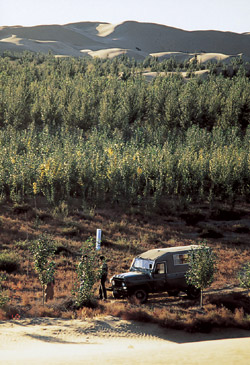 A planted saji forest in the Gobi Desert.
|
|
The Japan Association for Greening Deserts is promoting the planting of poplars and fruit trees like saji in five areas of the Gobi Desert in Inner Mongolia, China. More than 10 million trees have been planted so far.
About 20 years ago, Toyama Masao, the association director, became one of the first researchers to study the water-retention properties of high polymer plastics. Toyama is also an expert in applying agricultural techniques to arid areas, and has made a name for himself by using his plastic to change desert into farmland. He calculated the amount of water-retaining plastic to be mixed in earth under specific conditions, pulverized the plastic into granules, and developed technology that can be used to reverse desertification.
He says, "Plastic that absorbs water breaks down into hydrogen and carbon after about six months, so it has no negative impact on the environment."
Toyama has worked in Mexico, Egypt and the United Arab Emirates, helping to transform deserts into land suitable for agriculture.
"Each desert has its own characteristics. The desert in Mexico is influenced by the ocean nearby, while Egypt and the United Arab Emirates have hot, exceptionally dry deserts. The Gobi Desert is cold for much of the time." He adds in a modest tone of voice, "I have enough experience now to be able to make a desert bloom, wherever I'm asked to go."
|